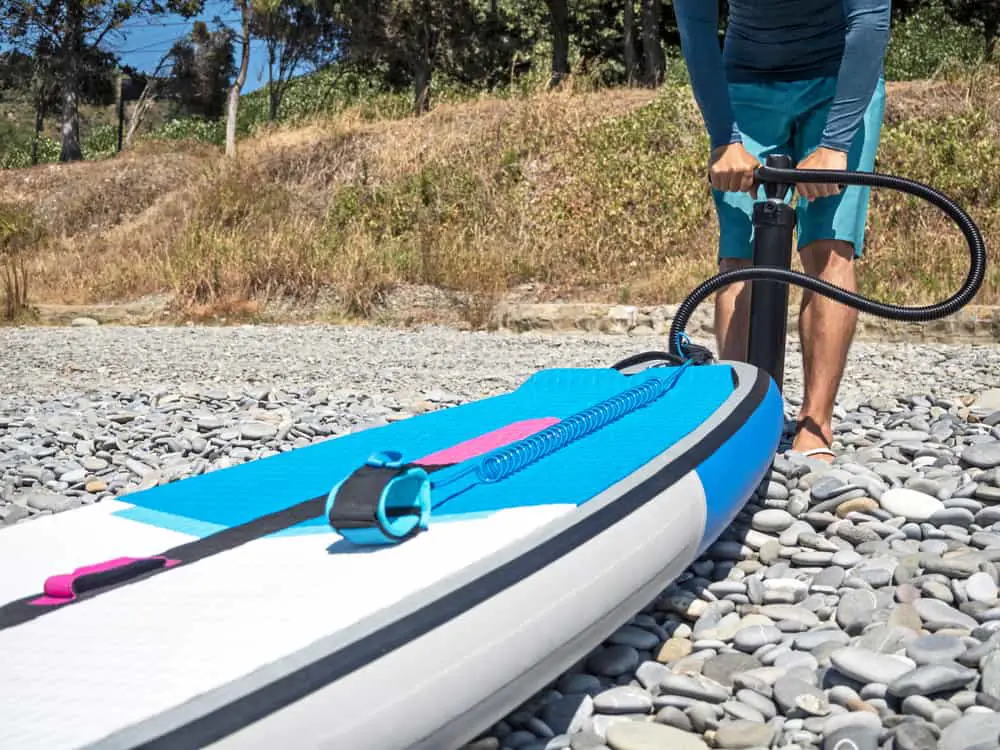As an Amazon Associate we earn from qualifying purchases.
Paddleboarding is an increasingly popular water sport that requires an individual to use their arms to propel themselves forward through the water while they either lie, kneel or stand on the paddleboard.
Stand up paddleboarding (neatly termed SUP) is a sport that has existed for thousands of years, but only recently has it grown in popularity to the point that it’s now a worldwide phenomenon.
Due to its increased popularity, more and more innovation has come to the sphere of paddleboarding. Among the most significant, inflatable SUPs.
Now this brings us to the crux of the matter. Inflatable SUPs or the more traditional hard SUPs? What’s the difference between the two and which are better?
The simple answer is that both offer their own distinct advantages and disadvantages and figuring out which type is right for you all depends on your needs and lifestyle.
To help make this potentially difficult decision much easier, we’re going to run through some of the key considerations to take into account when making your choice!
Table of Contents
Portability
In terms of transportation, inflatable SUPs are by far the most portable. You won’t need a large truck or van, because when deflated, inflatables can roll up to a size similar to that of a sleeping bag.
Most inflatable SUP kits tend to be the size and weight of a suitcase, easy for flying with and ideal for those living in small city apartments or small homes. No airport fees and no special racks in your home, not bad right?
When transporting hard boards however, you’ll need a larger car or car racks. They also weigh significantly more so they’ll be heavier to carry to and from the water.
Despite this, it is worth keeping in mind that with a hard board you’ll be ready to go straight away, whereas for inflatables, they’ll need to be inflated and deflated before and after you go paddleboarding.
Performance
Performance is always a key consideration, and in this case, hard boards provide higher quality performance compared to inflatables. While inflatables offer greater weight support and stability, hard paddle boards outperform similarly sized inflatable boards in speed and maneuverability.
They also offer better glide and tend to maintain momentum a lot better than inflatable boards, mainly due to the fact a lot of inflatables have fat planing hulls that possess the same level of thickness from nose to tail.
So if you’re planning to use your paddle board for activities such as SUP surfing or SUP racing, the hard board will be best suited.
Storage
A notable difference between inflatable and hard paddle boards is the ability to store the two. Inflatables can be stored pretty much anywhere in your home so if you live in a small apartment or a house with no garage, then an inflatable paddle board is probably your best bet.
For hard boards, it’s important to think about where you’d store them during the summer and off season. Ranging from 9-12 feet in length, they’re quite a hassle to transport from one place to another.
Yes, you could store them in your spare room or your garage, but you’d still need plenty of clearance to maneuver the board in and out of your home.
Durability
In terms of durability, inflatable boards are significantly harder to damage and will withstand the majority of common incidents with very little damage.
This is because they’re made from military-grade PVC protecting a tight drop stitch core, the layered construction of inflatable boards thus balances firmness with impressive levels of durability.
Since inflatables are more durable, they’re well suited in particular for white water paddling or paddling through rocky water.
Management
Despite hard boards being less durable, they tend to be easier to manage and repair than their inflatable counterparts.
While many of the common drops and scratches won’t do anything to an inflatable, more significant damage such as a puncture to a seam will prove more difficult to repair than a crack in a hard board.
In addition to this, both inflatables and hard boards are prone to degrade with prolonged sun exposure. For inflatables this is typically issues with the glue and PVC holding the board together, while for hard boards it’s discoloration and a weaker outer layer. Between the two, the problems that affect hard boards impact overall performance less compared to inflatables.
Therefore, the typical damage and degradation that comes with regular and prolonged SUP use are easier to repair and manage with a hard paddle board.
Weather
Regardless of which board you’re using, paddleboarding in extreme wind or torrential rain is never the best idea. However, for inflatable boards, even light wind can have a significant impact, and moving towards moderate wind conditions, it can be almost impossible to use a SUP.
While there will still be a performance loss in similar conditions for hard boards, they can handle windy conditions much better than inflatables. This provides you with greater flexibility, meaning you don’t have to constantly wait for the perfect day to get out on the water.
Frequently Asked Questions
Why are paddle boards inflatable?
Inflatable paddle boards are a reasonably new addition to the world of SUPs. Their biggest advantage is that they’re super easy to store and transport compared to hard boards.
While they may fall short in terms of performance as opposed to their hard counterparts, inflatables are a great option for individuals looking to travel with their boards.
Are inflatable paddle boards harder?
Inflatable SUPs are more durable as well as being softer than a hard board. With inflatables you’ll have more protection than hard SUPs and because of its inflatable nature, be less likely to hurt yourself should you happen to fall on it.
Amazon and the Amazon logo are trademarks of Amazon.com, Inc, or its affiliates.

